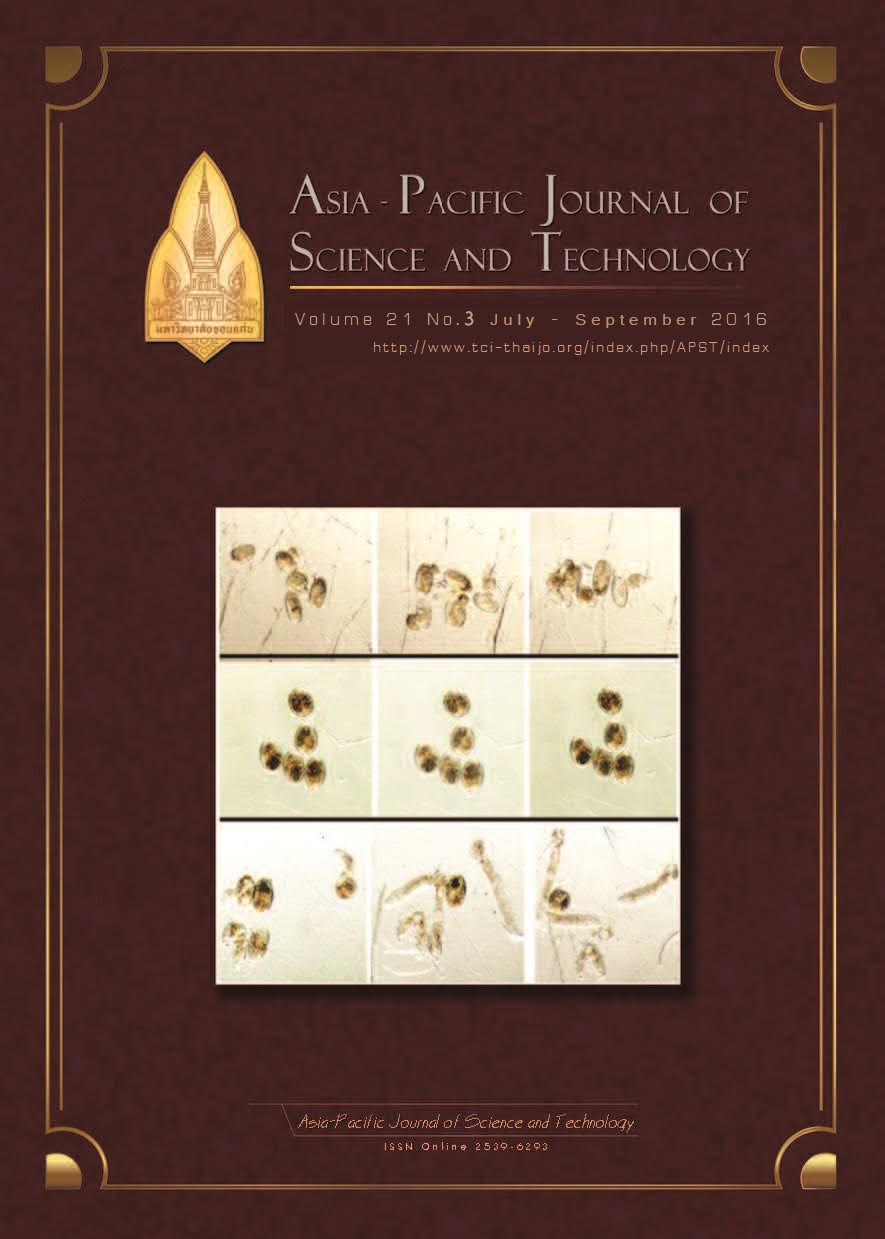Prevalence and characteristics of metabolic syndrome in northeast Thai patients with obstructive coronary artery disease
Main Article Content
Abstract
Background: Metabolic syndrome (MetS) is a risk factor for coronary artery disease (CAD) and is associated with adverse outcomes. However, the prevalence and characteristics of MetS in Northeast (NE) Thai patients with obstructive CAD has not been demonstrated.
Objective: This study examined the prevalence and characteristics of MetS in NE Thai patients with obstructive CAD.
Methods: We studied 120 consecutive patients with evidence of obstructive CAD, which was defined by diameter stenosis of 50% or more in at least one epicardial coronary artery detected by elective coronary angiography between 2008 and 2011. MetS was defined by a combination of the International Diabetes Federation (IDF) and National Cholesterol Education Program Adult Treatment Panel III (NCEP-ATPIII) criteria.
Results: A total of 120 subjects were included in our study cohort (median age 63 [56-66.5], 71% were men and the median body mass index (BMI) was 24 [22.3-27.6] Kg/m2). The prevalence of MetS was 75% and occurred more frequently in men (62.2% of MetS cases). The patients with MetS had significantly higher BMI (25.21 [IQR: 23.43-28.04] vs. (23.60 [21.3-24.5], p =0.001), waist circumference (91.25 [87-97] vs. 86 [82-89], p=0.01), fasting plasma glucose (102 [91-129.5] vs. 89 [85-97], p=0.009), triglyceride (191 [142-269] vs. 140 [99-178], p=0.003) and rates of hypertension (85.6% vs. 36.7%, p<0.001). Low high-density lipoprotein (HDL)- cholesterol (96.7%) and hypertension (85.6%) were the most frequent components of MetS.
Conclusions: There was a high prevalence of MetS among NE Thai patients with obstructive CAD and it was associated with low HDL cholesterol and hypertension.
Article Details
References
Mozaffarian D, Benjamin EJ, Go AS, Arnett DK, Blaha MJ, Cushman M, et al. Heart disease and stroke statistics--2015 update: a report from the American Heart Association. Circulation. 2015;131(4):e29-322.
Fihn SD, Blankenship JC, Alexander KP, Bittl JA, Byrne JG, Fletcher BJ, et al. 2014 ACC/AHA/AATS/PCNA/SCAI/STS focused update of the guideline for the diagnosis and management of patients with stable ischemic heart disease: a report of the American College of Cardiology/American Heart Association Task Force on Practice Guidelines, and the American Association for Thoracic Surgery, Preventive Cardiovascular Nurses Association, Society for Cardiovascular Angiography and Interventions, and Society of Thoracic Surgeons. Circulation. 2014;130(19):1749-67.
Ford ES, Ajani UA, Croft JB, Critchley JA, Labarthe DR, Kottke TE, et al. Explaining the decrease in U.S. deaths from coronary disease, 1980-2000. The New England journal of medicine. 2007;356(23):2388-98.
Eckel RH, Alberti KG, Grundy SM, Zimmet PZ. The metabolic syndrome. Lancet. 2010;375(9710):181-3.
Isomaa B, Almgren P, Tuomi T, Forsen B, Lahti K, Nissen M, et al. Cardiovascular morbidity and mortality associated with the metabolic syndrome. Diabetes Care. 2001;24(4):683-9.
Lakka HM, Laaksonen DE, Lakka TA, Niskanen LK, Kumpusalo E, Tuomilehto J, et al. The metabolic syndrome and total and cardiovascular disease mortality in middle-aged men. Jama. 2002;288(21):2709-16.
Isomaa B, Henricsson M, Almgren P, Tuomi T, Taskinen MR, Groop L. The metabolic syndrome influences the risk of chronic complications in patients with type II diabetes. Diabetologia. 2001;44(9):1148-54.
Hildrum B, Mykletun A, Hole T, Midthjell K, Dahl AA. Age-specific prevalence of the metabolic syndrome defined by the International Diabetes Federation and the National Cholesterol Education Program: the Norwegian HUNT 2 study. BMC Public Health. 2007;7:220.
Patel A, Huang KC, Janus ED, Gill T, Neal B, Suriyawongpaisal P, et al. Is a single definition of the metabolic syndrome appropriate?--A comparative study of the USA and Asia. Atherosclerosis. 2006;184(1):225-32.
Hillis LD, Smith PK, Anderson JL, Bittl JA, Bridges CR, Byrne JG, et al. 2011 ACCF/AHA Guideline for Coronary Artery Bypass Graft Surgery. A report of the American College of Cardiology Foundation/American Heart Association Task Force on Practice Guidelines. Developed in collaboration with the American Association for Thoracic Surgery, Society of Cardiovascular Anesthesiologists, and Society of Thoracic Surgeons. J Am Coll Cardiol. 2011;58(24):e123-210.
Alberti KG, Zimmet P, Shaw J. The metabolic syndrome--a new worldwide definition. Lancet. 2005;366(9491):1059-62.
Grundy SM. Metabolic syndrome pandemic. Arterioscler Thromb Vasc Biol. 2008;28(4):629-36.
Bhatt DL, Steg PG, Ohman EM, Hirsch AT, Ikeda Y, Mas JL, et al. International prevalence, recognition, and treatment of cardiovascular risk factors in outpatients with atherothrombosis. Jama. 2006;295(2):180-9.
Go AS, Mozaffarian D, Roger VL, Benjamin EJ, Berry JD, Blaha MJ, et al. Heart disease and stroke statistics--2014 update: a report from the American Heart Association. Circulation. 2014;129(3):e28-e292.
Sattar N, Gaw A, Scherbakova O, Ford I, O'Reilly DS, Haffner SM, et al. Metabolic syndrome with and without C-reactive protein as a predictor of coronary heart disease and diabetes in the West of Scotland Coronary Prevention Study. Circulation. 2003;108(4):414-9.
Kim LK, Yoon JW, Lee DH, Kim KM, Choi SH, Park KS, et al. Impact of metabolic syndrome on the progression of coronary calcium and of coronary artery disease assessed by repeated cardiac computed tomography scans. Cardiovasc Diabetol. 2016;15:92.
Gorter PM, Olijhoek JK, van der Graaf Y, Algra A, Rabelink TJ, Visseren FL. Prevalence of the metabolic syndrome in patients with coronary heart disease, cerebrovascular disease, peripheral arterial disease or abdominal aortic aneurysm. Atherosclerosis. 2004;173(2):363-9.
Ahmed HM, Blaha MJ, Nasir K, Rivera JJ, Blumenthal RS. Effects of physical activity on cardiovascular disease. Am J Cardiol. 2012;109(2):288-95.
Kant AK, Whitley MI, Graubard BI. Away from home meals: associations with biomarkers of chronic disease and dietary intake in American adults, NHANES 2005-2010. Int J Obes (Lond). 2015;39(5):820-7.
Al Dhaheri AS, Mohamad MN, Jarrar AH, Ohuma EO, Ismail LC, Al Meqbaali FT, et al. A Cross-Sectional Study of the Prevalence of Metabolic Syndrome among Young Female Emirati Adults. PLoS One. 2016;11(7):e0159378.
Phababpha S, Kukongviriyapan U, Pakdeechote P, Senggunprai L, Kukongviriyapan V, Settasatian C, et al. Association of arterial stiffness with single nucleotide polymorphism rs1333049 and metabolic risk factors. Cardiovasc Diabetol. 2013;12:93.


